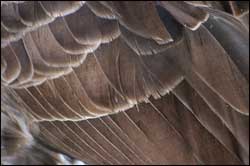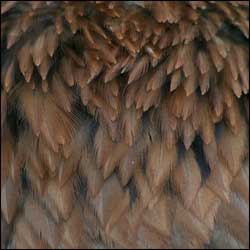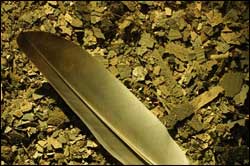Feathers
What a unique thing a feather is. It is one of the lightest and most flexible materials formed by any animal, and it is produced only by the bird. Although simple in form, it is amazingly complex in design, with all its branching parts.

To give you an idea of its complex nature, a six-inch flight feather from a pigeon may have as many as 1,200 feathery barbs extending from the sides of its center shaft. Even the shortest of these barbs may, in turn, have 275 pairs of barbules extending from its sides. To carry it even further, each of the more than 660,000 barbules has tiny, microscopic barbicels along it that end in interlocking booklets. All of these tiny parts of the feather join together. If you separate them and then smooth them together, they will rejoin as neatly as a zipper closes.
Feathers are not all alike. They vary in size, color, shape, and structure. In fact, it takes several different kinds to make up the body covering of one bird, as the photograph of the different feathers found on a pheasant shows. Some, such as the wing and tail feathers, are smooth and relatively stiff; others, such as the downy feathers next to the skin, are soft and fluffy; still others are a combination of the two.
Each feather sprouts from a follicle, which is a tiny pit in the bird's skin. Blood carries oxygen and food to the growing feather through an opening at the base of its shaft, but when the feather is fully grown, this opening closes and the feather "dies." Since a full-grown feather is "dead," a bird feels no more pain when its feathers are cut than you feel when your hair is cut. If a feather is pulled out, another immediately begins to grow in its place. Feather growth is fast, often as much as a quarter inch or more a day.

As the feather grows from the follicle, it is enclosed in a protective sheath of keratin (cARE-uh-tin), the same substance that forms your fingernails and the bird's beak and claws. These enclosed feathers give a baby bird a porcupine-quill look as they begin to sprout; however, once a certain stage of growth is reached, the tip of the sheath splits open and the end of the feather is released. With time, more and more of the sheath breaks away or is preened off by the bird until the whole feather is released and allowed to take its proper shape. Even though it looks as if the bird's entire body is covered with feathers, almost all birds grow feathers only from restricted, well-defined areas called tracts. The bare skin areas are covered by overlapping feathers.
At least once a year the bird grows a new covering of feathers. The follicles begin to produce new feathers that eventually push out the old ones. This process, known as the molt, enables the bird to replace all of those feathers damaged by the wear and tear of everyday living. Birds that have had their wing feathers clipped to prevent them from flying replace these cut feathers with flight-capable feathers during the molt and must be clipped again if they are to be kept flightless. The molt, which occurs just after the breeding season while the weather is still warm, also allows the colorful males to trade their bright breeding feathers for ones with more concealing colors. A second complete or partial molt the next spring will produce their colorful plumage again in time for the breeding season.
The molt is not a haphazard replacement of feathers, but proceeds in a very orderly way with only a few feathers involved at a time. Otherwise the bird would be both naked and flightless during the molt. Molting usually begins with the flight feathers and progresses in stages, so there are enough flight feathers at all times for the bird to fly. To keep the bird in balance, feathers located on opposite sides of the body are replaced at the same time. Once all the flight feathers are replaced, the body molt begins and progresses from tail to head. Waterfowl, however, molt in a different manner. They replace their body feathers first and then lose all their primary flight feathers at the same time. This leaves them unable to fly, and they must rely on the water and vegetation to protect and hide them from predators.

Other than flight, the main function of a bird's feathered covering is to protect the bird from the weather. However, to do this effectively, the feathers require constant attention. Birds must tirelessly preen – arranging, rearranging, smoothing, and waterproofing their plumage. An oil gland located above the base of the tail provides the waterproofing substance for most species. The bird transfers the oil to its beak by massaging the gland and then rubs its beak through the feathers to dress and waterproof them. As the bird draws the feathers through its beak, they are smoothed and arranged to its satisfaction.
Some birds, such as parrots, herons, and bitterns, have special feathers to provide a waterproofing dust for their preening efforts. These "powder down" feathers continue to grow as long as they are attached to the body; however, their tips disintegrate into a water-resistant, talclike powder. These special feathers may grow in solid patches on the breast or lower back, or they may be found throughout the plumage, as on parrots. Vigorous ruffling and preening distribute the powder over the bird's body and waterproof the feathers.
Feathers are a good insulating material. By fluffing its feathers, a bird traps many tiny pockets of air to hold in body heat and keep out the cold. The tiny air spaces formed within a waterfowl's feathers cause it to float high in the water as if it had a built-in air mattress. If these air pockets are destroyed, the bird's body floats almost submerged. When the insulating air pockets or protective waterproof qualities are destroyed by such things as an oil slick or detergents in the water, the bird's oil- or water-soaked feathers prevent it from swimming or flying, and it eventually dies from exposure to the cold water and weather.
When the weather is hot, the bird presses its feathers close to its body to eliminate the insulating air pockets so that body heat is allowed to escape. Since the molt also takes place during the hottest part of the year, fewer feathers are present then to insulate the body. The insulating quality of feathers is a drawback when the bird is trying to incubate its eggs. The feathers keep some of the body heat from reaching the eggs. To overcome this problem, the bird either sheds some of its breast feathers naturally or pulls them out to expose the bare skin. This bare area is called the brood patch, and egg temperatures next to it may be as much as six degrees higher than those next to the feathers.
Feathers also make birds one of the most colorful groups in the animal kingdom, but their colors can be deceiving. Most of the reds, yellows, oranges, and browns come from color pigments in their food and can change with their diet. If a yellow canary is fed red peppers, its feathers gradually will change to bright orange with successive molts. These pigmented colors result from chemical compounds called carotenoids (ker-AH-te-noids) that are deposited in the growing feathers.
Blue, on the other hand, is produced by a colorless layer of cells with surfaces that scatter the light and reflect only blue wavelengths of light to the human eye. Greens are a combination of blue-reflecting structure and yellow pigments. Iridescent feathers have tiny ridges and platelets that reflect colors according to the angle of light. This explains how the throat of the ruby-throated hummingbird can flash from orange-red to crimson to black. It also explains the changing greens, purples, and bronzes of the grackle's breeding feathers.
When an excess of brown or dark pigment forms in the feathers, the bird will appear darker than the other members of its species. This condition is called melanism (MEL-uh-niz-um). If a molting bird is subjected to high humidity, darker colors may result. The complete absence of pigments produces white, and if this condition occurs throughout the bird's body, it is known as albinism (AL-buh-niz-um). Pure albinos are snow-white with red or pink eyes. The red or pink color in the eyes is caused by the blood showing through the unpigmented iris.
Feathers are so beautiful in color and pattern that people have used them for adornment for thousands of years. At times greed for these feathered decorations has endangered whole bird populations. Let us hope that we have learned a lesson from the past and will realize that a truly beautiful place for a feather to be is on the body of a wild bird.
Ilo
Hiller
1989 – Feathers: Introducing Birds to Young
Naturalists. The Louise
Lindsey Merrick Texas Environment
Series, No. 9, pp. 5-8.
Texas A&M University
Press, College Station.